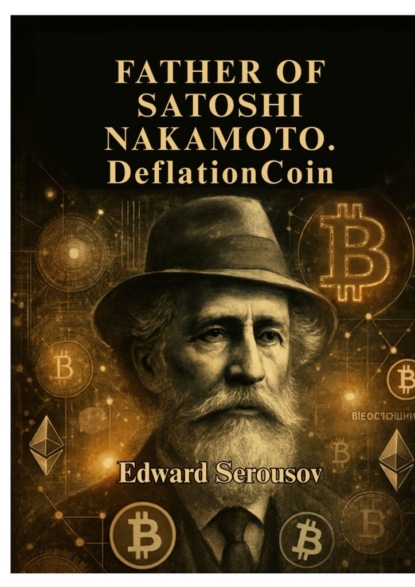Father of Satoshi Nakamoto. DeflationCoin

- -
- 100%
- +
While these projects position their technologies as foundational, their real-world application in the daily lives of ordinary citizens remains rare. The “technological” branding of such projects is often nothing more than a marketing ploy aimed at attracting capital from naïve investors. In practice, these projects lack a true deflationary model, limited supply, and fail to orient their products toward mass adoption beyond the crypto industry, which diminishes their real value and limits growth potential.
This critique applies partially to Bitcoin as well. While Bitcoin does have a limited supply and a minor deflationary aspect caused by the loss of wallet access by some users, this deflation is a random occurrence rather than the result of a deliberate economic model. Moreover, Bitcoin lacks an internal economy capable of driving sustainable demand for its coins. For this reason, it cannot be considered the leader among cryptocurrencies in terms of coin value or a reliable tool for long-term capital preservation.
Inflation negatively impacts government bonds worldwide, reducing their real returns and diminishing their appeal to investors. Considering that the global government bond market exceeds $130 trillion, the devaluation of these assets due to inflation creates significant pressure on the global economy.
Unlike bonds, Bitcoin benefits from inflation, which has contributed to its continued value growth. However, if Bitcoin had been designed from the outset with a well-thought-out deflationary model and an internal economy, its market capitalization could have reached far more impressive heights.
3.2. Daily Smart-Burning of Coins
One of the mechanisms that reduces the circulating supply of DeflationCoin is the Daily Smart-Burning of Coins.
Mechanism Functionality:
– Once Wallet A transfers coins to Wallet B, 1% of the received amount is automatically deducted from Wallet B after 24 hours.
The only way for Wallet B to avoid this deduction is to transfer the coins into Smart-Staking within 24 hours (details provided in Section 3.4).
In Smart-Staking, tokens are protected from being burned and can increase in quantity through the “Staking Rewards Program” (see Section 3.5).
Coin Deduction Process:
– 50% of the deducted coins are sent to a wallet where they are permanently removed from circulation.
– 50% are sent to a wallet for redistribution as rewards for stakers (details provided in Sections 3.4 and 3.5).

3.3. Deflationary Halving – Unlike Bitcoin
One of the key mechanisms controlling Bitcoin’s inflation is halving. Halving is the process by which the reward miners receive for creating new blocks is reduced by half every 210,000 blocks (approximately every 4 years). This mechanism limits Bitcoin’s total supply to 21 million coins, creating scarcity and helping control inflation.
However, halving does not make Bitcoin a truly deflationary asset – it only slows down the rate at which new coins are created, rather than reducing the number of coins in circulation. In this regard, Bitcoin is not unique, as many stocks on the financial market, which do not issue additional shares, also have a fixed supply in circulation, making them similar to Bitcoin in terms of their supply model.
DeflationCoin implements the “Deflationary Halving” mechanism.
After Wallet A transfers coins to Wallet B, 1% of the received amount is deducted from Wallet B after 24 hours (this occurs if Wallet B does not transfer the coins to “Smart-Staking” within 24 hours).
With each subsequent day, the deduction percentage doubles. This means that at the beginning of each new day, an updated deduction percentage is applied to the remaining balance, as outlined in the table below.
Table №1: Deflationary Halving.

Therefore, if Wallet B does not transfer its coins to “Smart-Staking” within 8 days, its balance will be completely depleted.
Thanks to the “Deflationary Halving” mechanism, the economic model of DeflationCoin not only ensures a limited supply but also continuously reduces the number of coins in circulation. This mechanism incentivizes participants to transfer their coins into “Smart-Staking.”
3.4. Smart-Staking
Emotions have a significant impact on market traders. Fear, greed, euphoria, or panic can distort the perception of market situations, leading to deviations from pre-planned trading strategies and impulsive decision-making. As a result, traders often experience behavioral biases, such as the “herd effect” or “confirmation bias”, which significantly reduce their effectiveness in the market.
Due to the destructive influence of emotions on decision-making, many institutional market participants, including hedge funds, prefer algorithmic trading. Automating trading operations increases the accuracy of trade execution and reduces the likelihood of errors caused by psycho-emotional reactions, making trading more predictable and systematic.
Automating trading operations improves execution accuracy and reduces the likelihood of errors caused by emotional reactions, making trading more predictable and systematic.
During the early stages of Bitcoin’s promotion, it was extremely difficult to assess its potential. Many investors bought the asset at $10 and sold it at $20, satisfied with doubling their profit. However, only a few managed to hold the asset long-term and achieve returns in the hundreds of thousands of percent. For most, emotions played a decisive role: fear of losses and the desire to lock in quick profits led them to sell too early, missing out on enormous growth opportunities. Looking back, many became victims of a cognitive bias known as hindsight bias: Bitcoin’s rapid growth seems obvious only in retrospect, though predicting its potential at the time was highly challenging.
Smart-Staking is an advanced version of traditional staking, designed to eliminate emotional factors. The core idea of staking is to lock funds to support blockchain operations, where users assist in verifying transactions and creating new blocks. The longer funds remain locked, the higher the reward. Unlike mining, which requires significant computational power, staking is a more energy-efficient process.
The key difference between smart-staking and traditional staking lies in removing the human factor. It operates as an “emotionless mechanism”, encouraging long-term holding. Additionally, smart-staking serves as a reliable source of passive income, ensuring the growth of coins.
Transferring funds to smart-staking locks, the possibility of selling them until the process is completed, which prevents premature sell-offs under the influence of emotions. This safeguards against premature sales driven by emotions. Unlike bonds that offer only minimal returns, smart-staking provides stable income with the potential for substantial asset appreciation. This makes it possible to increase profits tens or even hundreds of times, ahead of those who prematurely exit positions under the influence of emotions.
Warren Buffett once remarked, “The Stock Market is Designed to Transfer Money from the Active to the Patient”.
Empirical data supports this statement. Research conducted by financial firms such as Fidelity revealed that the most profitable accounts in the long term were those where investors made no changes to their portfolios or had no ability to interfere – including accounts belonging to deceased clients. The statistical pattern here is clear: active asset management and the pursuit of short-term market gains often lead to errors and losses, whereas a passive approach and long-term strategy allow for maximizing profits through the natural growth in market asset values.
This is why the investment lock-in periods in Smart-Staking are designed for long-term intervals: ranging from 1 year to 12 years. Compared to the average human lifespan, these durations may seem relatively short but are optimal for building significant wealth. Through long-term staking, DeflationCoin can compete with pension funds worldwide, whose efficiency and transparency have increasingly been called into question over the past decades.
Details of the Smart-Staking parameters are presented in the following table.
Table №2: Smart-Staking Parameters.

The “Staking Rewards Program” with monthly payouts is activated when tokens are staked for a period of 2 years or more. When Wallet A stakes coins for 2 years, its initial multiplier is x2. After one year, this multiplier decreases to x1 and continues to decline annually. The same principle applies to the PoD decision-making mechanism, but with different multipliers.
Important!
– Participants in Smart-Staking can increase the multiplier (X) for coins already staked at any time by extending the staking duration.
Since the inception of the S&P 500 index in 1957, economic crises have occurred, on average, every 8.5 years. For this reason, access to the PoD (Proof of Decision) mechanism is granted only to participants who have staked their coins for a minimum of 8 years.
A participant making decisions about the project’s development must recognize that, during their staking period, they are highly likely to encounter an economic crisis. This is crucial because macroeconomic shocks often lead to the collapse of many companies. As the famous market saying goes, “Only when the tide goes out do you discover who’s been swimming naked.”
The longer a participant’s funds remain locked in staking, the greater the weight of their tokens in decision-making. Participants who take greater risks have greater influence.
Historically, all economic crises have ultimately been accompanied by increased money supply and rising inflation. This is because governments and central banks frequently implement monetary and fiscal stimuli to stabilize economies. These measures, ranging from lowering interest rates to large-scale quantitative easing programs and direct payments to the population, inject additional money into the economy.
As a result, any crises in different countries of the world will only become a catalyst for the growth of “DeflationCoin”. These events should be considered as opportunities for further development.
Therefore, Smart-Staking offers the following advantages:
– Minimization of Emotional Influence.
Smart-Staking helps participants avoid impulsive decisions caused by short-term emotional reactions. By locking their funds for a specified period, investors lose the ability to sell assets during moments of panic or euphoria. This allows them to stay committed to the project for the long term, significantly increasing their chances of achieving multifold returns (10x, 100x, 1000x). Moreover, stabilization of the behavior of individual participants has a positive effect on the overall success of the project, ensuring sustainable growth and reducing the risk of sudden price drops.
– Opportunity to Receive Monthly Rewards.
(Details provided in Section 3.5)
– Positive Impact on Marketing Strategy.
The longer an investor holds their assets in staking, the more engaged they become with the project, which contributes to its further promotion. Investors naturally become active participants in spreading information, enhancing the word-of-mouth effect. An important aspect is habit formation: according to neuroscientific research, forming a lasting habit takes anywhere from 18 to 254 days.
Accordingly, long staking periods facilitate deeper integration of the project into participants’ lives, positively influencing its promotion.
– Positive Impact on the Project’s Technical Development.
Long-term investors become more interested in the development of the project, since their investments are linked to its future success. This strengthens their connection with the project and also stimulates their active participation in key decisions whether it’s voting on project changes, developing marketing strategies, or selecting new growth directions. Such involvement enhances the project’s technical support and strategic planning.
– Formation of a Low-Correlation Asset Independent of Global Markets.
One of the key issues for most exchange-traded assets is their high correlation, particularly during economic crises. Under global market stress, most assets tend to move in the same direction, making capital protection through diversification nearly impossible. With its Smart-Staking, DeflationCoin provides a solution to this problem: the long-term locking of assets minimizes the impact of short-term speculation and reduces correlation with global markets. As a result, DeflationCoin remains stable even during periods of economic instability, when traditional assets decline simultaneously.
The story of Laszlo Hanyecz, who bought two pizzas for 10,000 bitcoinsin 2010, serves as a vivid example of how impulsive decisions can lead to missing out on huge opportunities. At the time, those bitcoins were worth just $41, but years later, their value could have reached hundreds of millions of dollars.
If Laszlo had used the Smart-Staking mechanism, his bitcoins would have been locked for a long period, preventing premature sale and allowing him to realize multifold profits.
Smart-Staking addresses one of the primary challenges investors face: the impact of emotions on decision-making. This mechanism not only prevents impulsive actions but also creates conditions for long-term sustainable growth, maximizing profits by locking assets and minimizing speculative risks.
For investors focused on stable outcomes, Smart-Staking is a reliable tool for achieving long-term financial goals.
3.5. Staking Rewards Program
In many modern blockchains such as Ethereum and Solana, staking rewards are paid out through new token issuance. Essentially, this model resembles inflationary fiat currencies, where “rewards” come at the cost of value dilution. The direct opposite of this approach is Bitcoin, which earned its status as “digital gold” due to its strictly limited supply. However, Bitcoin offers no holder incentives – the token simply sits idle in wallets.
In contrast, DeflationCoin combines the best of both worlds: rewards are available to holders, but they are not tied to inflation or the creation of new tokens. All payouts are generated from a predefined limited pool, with no increase in total supply. This allows participants to benefit from long-term engagement without undermining the scarcity of the asset.
Users who commit their tokens to a smart-staking program for 2 years or more are eligible for monthly reward payouts, which include two components:
– A partial release of tokens from the personal wallet;
– A reward distributed from the common pool with consideration of the X-multiplier.
Payouts are made monthly based on the following formula:

Formula Parameters:
– W – monthly payout;
– S – total number of coins in staking;
– M – originally specified staking duration in months;
– D – reward paid from the global pool with the X-multiplier applied.
Before the reward is paid out, a global pool is formed each month from the following income sources:
– Coin deductions according to the “Smart-Burning” mechanism.
– Smart fees.
– “Deflationary Ecosystem Pool” (details in section 5).

The final distribution of the reward share, adjusted with the X-multiplier, is calculated using the following formula:

Formula Parameters:
– D – Reward paid to the smart-staking participant. The base calculation formula is:

– P – Pool income, the total amount of reward distributed among participants;
– — Final ownership share, adjusted for the X-multiplier and expressed as a percentage. The calculation formula is:


– — Total -score of all wallets.


– — Intermediate ownership share for a specific wallet, adjusted for the X-multiplier. The calculation formula is:


– — X-multiplier for a specific wallet.

– — Ownership share of coins, expressed as a percentage. The calculation formula is:


– — Number of coins in a specific wallet.

– S – Total number of coins from all wallets participating in smart-staking.
A distribution example is presented in the next table. For demonstration purposes:
– Pool income (P) is set to 130.
– Random values are used for the X-multiplier and number of coins in smart-staking.
Table №3: Example Calculation of “Staking Rewards”

Important!
– Reward payouts are not guaranteed or mandatory. If a staker prefers to accumulate capital in the long term by leveraging compound interest and the law of exponents, they can opt out of the monthly payout function and continue accumulating coins until the funds are unlocked.
– According to the formula, the reward payout is limited to the amount accumulated in the pool during the month. Stakers with higher X-multipliers receive a larger share of the pool, with no additional coin issuance involved.
If a Smart-Staking participant did not activate the “Reward Payout” mechanism every month – or did not activate it at all – the remaining tokens will be unlocked upon completion of the Smart-Staking period in accordance with the “Gradual Unlock” principle (see Section 3.6).
3.6. Gradual Unlocking
The price of any asset is determined by the actions of one decisive and highly motivated participant, not by the consensus of many. If such a participant can emerge only among buyers, not sellers, the asset’s price will inevitably rise.
The “Gradual Unlocking” mechanism is a key element in DeflationCoin’s pricing model. By gradually releasing coins from Smart-Staking, strong selling pressure is eliminated, while strong buying potential is maintained.
Coin unlocking after the completion of Smart-Staking occurs daily and is calculated using the following formula:

Formula Parameters:
– — Number of coins unlocked per day.

– — Total number of coins in Smart-Staking at the start of the unlocking period.

– — Accumulated unpaid rewards over the staking period.

– — Number of years the coins were locked in Smart-Staking.

Bitcoin has repeatedly experienced price declines of over 80%, making it difficult to position it as a reliable storing value. At any moment, investors may face significant capital losses.
Sudden price drops on cryptocurrency exchanges often occur in a domino effect:
– A stop-loss order from one participant triggers a price drop.
– This activates stop-loss orders from others, causing a chain reaction.
– High leverage amplifies this process: liquidations of highly leveraged positions lead to further sales, accelerating the asset’s collapse.
– Panic among some participants provokes panic among others, resulting in substantial price declines.
The “Gradual Unlocking” mechanism minimizes the risk of mass sell-offs, reducing the influence of human factors and negative emotions. As a result, DeflationCoin is a more reliable storing value compared to Bitcoin, which has repeatedly suffered severe price crashes.
Such events can have a significant impact on systems, companies, markets, and even entire economies. Without proper protection against them, any risk management becomes merely an illusion of control. It is precisely low-probability risks that can lead to the most severe consequences, and neglecting them means lacking real control over risks as a whole.
In the case of Bitcoin, the risk of a sudden price drop: such as during the COVID-19 pandemic when major holders sold en masse and the price declined by more than 50%. With the “Gradual Unlocking” mechanism, such scenarios are effectively prevented in DeflationCoin.
3.7. Basket and Pump (BaP)
The “Gradual Unlocking” mechanism, described in the previous section, offers numerous advantages but also has certain disadvantages:
– Daily Selling of Unlocked Coins. Investors are required to sell unlocked coins daily, turning routine operations into repetitive tasks that could otherwise be automated.
– Challenges with Limit Orders for Coin Purchases. For investors seeking to build large positions, the process may take more than a day. Due to the “daily burning mechanism”, this would necessitate splitting the position into multiple smaller parts and entering them into Smart-Staking over several days.
To address these issues, the “Basket and Pump” (BaP) mechanism was developed. It works similarly to a tennis ball launcher: the “basket” accumulates balls (in this case, coins), while the “launcher” distributes them. The basket collects unlocked or acquired coins, and the launcher directs them either to Smart-Staking or to the exchange for automated selling. This mechanism simplifies and automates routine processes for investors.
The BaP mechanism is integrated into the Online Node (Section 3.15) and automates the following:
1. Selling DeflationCoin. During daily unlocking from Smart-Staking, coins can be partially or fully sold on the exchange at the investor’s discretion. The entire process is automated and can be activated with a single button, eliminating the need for investors to manually renew or sell their coins every day.
2. Buying DeflationCoin. For professional market participants who use limit orders, BaP simplifies the process of building positions by allowing accumulation over several days. These accumulated coins can be entered into Smart-Staking as a single position, avoiding the need to split them into smaller daily transactions. Conditions for this process:





